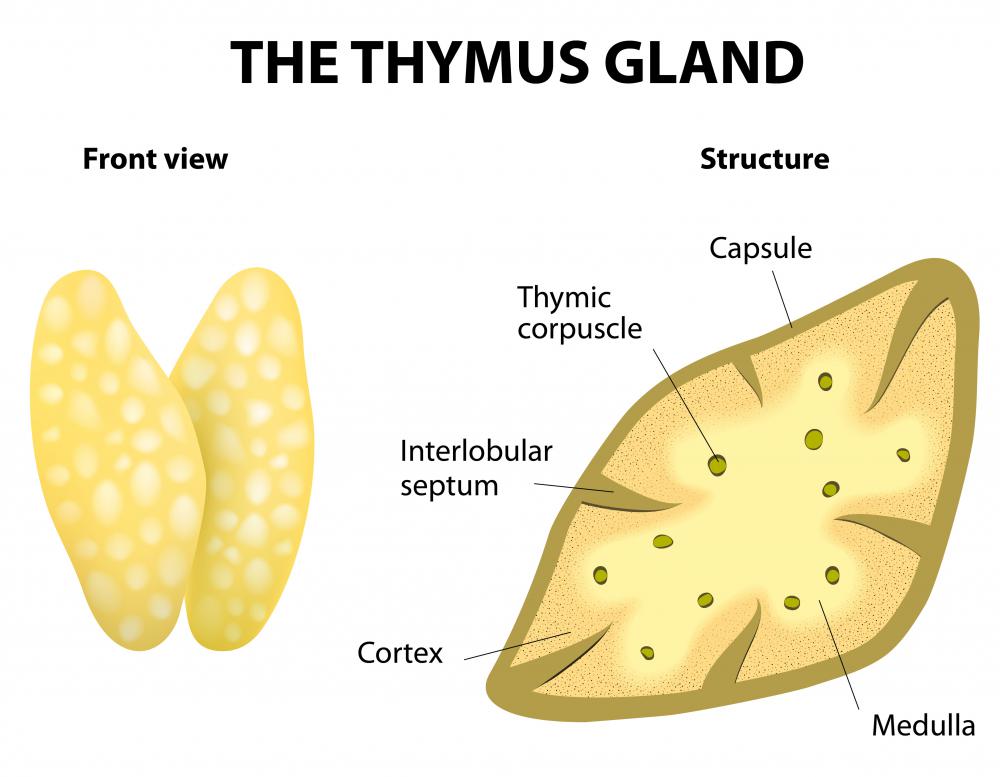At WiseGEEK, we're committed to delivering accurate, trustworthy information. Our expert-authored content is rigorously fact-checked and sourced from credible authorities. Discover how we uphold the highest standards in providing you with reliable knowledge.
What is the Purpose of Thymus Tissue?
The thymus gland is a grayish-pink, bi-lobed organ located in the chest behind the breastplate and in front of the heart. Involved in the immune system, the thymus gland's primary function is to produce specialized white blood cells called T-lymphocytes. The T-lymphocytes are largely responsible for fighting viruses, tumors, and foreign materials in the body. During this process, the thymus tissue transforms stem cells derived from the bone marrow into thymocytes, immature T-lymphocytes, and programs them for central tolerance. Central tolerance means that the immune cells will not react to the body’s other cells and tissues, a critical factor in the prevention of self-induced immune damage, or autoimmunity.
Clinical studies reveal that animals without thymus tissue react immunologically in a vastly different way than animals with normal thymus tissue. If the thymus gland is extracted before birth, the animals have remarkably little capacity to mount immune responses. They are more vulnerable than normal animals to all kinds of infection. These animals will tolerate transplants of foreign tissue without any sign of rejection, a sign that they do not have the ability to identify foreign tissue. Animals without thymus tissue also develop cancer more readily than their normal counterparts.

The thymus weighs approximately 15 grams (0.033 pounds) at birth. It continues to grow throughout early childhood, topping out at about 35 grams (0.077 pounds) at puberty. Thereafter, the thymus tissue begins to shrink, largely replaced with fatty tissue over time. By the age of 75, the thymus tissue weighs only about six grams (0.013 pounds). Atrophy of the thymus tissue with age partially explains the impaired immune function and increased risk of cancer in the elderly.

Early removal of the thymus gland, a technique called thymectomy, results in premature aging. Cardiovascular surgeons perform a thymectomy in order to gain access to the heart for cardiac surgery. Thymus cancer or myasthenia gravis may also necessitate this procedure. During fetal development, the thymus tissue produces an adequate number of T-cells, so thymectomy after birth does not create an inordinate T-cell deficiency.

Autoimmune diseases occur when the immune cells of the body react against the normal body tissues. These diseases rank among the ten most frequent causes of death in the elderly. Autoimmunity causes approximately 80 different conditions. In some of these diseases, such as myasthenia gravis, the thymus gland is swollen and hyperactive. The incidence of autoimmune diseases increases with age.

Immune deficiency is a situation in which the body’s ability to fight infection is limited or nonexistent. Pediatricians deal with more than 80 different primary immunodeficiency disorders, many of which produce an abnormality in T-lymphocyte function. Treatment for immunodeficiency may include long-term antibiotics, infusions of antibodies, or bone marrow transplants. Human immunodeficiency virus (HIV) is a virus that directly attacks the circulating T-lymphocytes and the thymocytes in the thymus gland.
AS FEATURED ON:
AS FEATURED ON:

















Discussion Comments
The thymus doesn't produce T-lymphocytes; bone does. The thymus acts as the site for T-lymphocyte/maturation.
Post your comments